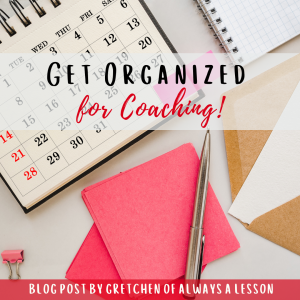Get Organized for Coaching!
Getting organized for instructional coaching is one way to increase the likelihood that you can have an impact on teacher growth. If a coach is unorganized, it is hard for them to be able to maintain a strong growth plan for a teacher, let alone multiple teachers. This post will help instructional coaches get organized for coaching prior to the school year starting (hint hint, doing things ahead of time is one way to be successful at organization!).
 Chat with Colleagues
Chat with Colleagues
Before you begin, it is helpful to chat with some colleagues who are also instructional coaches. Ask them what systems and processes they use. You don’t have to replicate what they use and how they use it, but it helps keep you from starting from scratch if you don’t have to. Plus, they’ll have helpful tips so you can avoid common pitfalls in terms of organization. If you have ideas of your own, this is the perfect time to run those by your colleagues. They can point out things you haven’t thought of or support your idea and encourage you to implement it for your teachers.
Design Your Work Space
If the space you operate in is messy, your brain will also become messy. This will keep you from completing tasks in a timely manner, decreasing the impact you can have with teachers. First, take stock of what furniture is available to you in your space- table, desk, chairs, bookshelves, etc. Think about how you plan to use those things.
- Chairs- Teachers can relax while they chat with you
- Tables – A planning space for collaboration
- Bookshelves- Store manipulatives for lessons, PD books to check out, binders of standards and pacing guides, etc.
Next, decide how you want to operate in the space. How can teachers reach you if you are not in your work space? Where should teachers drop off materials to you? What furniture placement makes the best use of space while also contributing to an inviting atmosphere?
Lastly, think through how you will store your items for easy reference and confidentiality.
The organization in your workplace sets the tone for the organization in how you show up and serve teachers.
Gather Materials
Whether you plan to use digital or hard copy materials, you’ll want to gather them in one place.
- Digital- Google drive or a schools hard drive is a good place to house all of the materials you will need to coach teachers. Create folders for grade levels, content areas, assessments, lesson plans, feedback forms, etc. The more you can niche down in topic for a folder, the better. You’ll want to make sure you can access these documents no matter where you are coaching, so choose wisely!
- Hard Copy- Grab a large binder to house master copies of coaching forms and materials. You can use manila folders or small binders per grade level/subject area or even teacher. Keep these binders nearby as you’ll need to reference them often, especially to make copies.
Ask your colleagues for templates of coaching forms they use, or browse here. You’ll want to gather or design coaching forms that walk teachers through the growth process from start to finish. This means you’ll start with interest surveys to get to know your teachers better before you dive into working with them, as well as more meaty materials like lesson observation, reflection questions, and/or growth plan documentation. (Some common categories are data, observations, and professional development.)
Not every form will be used with every teacher, but it is essential to have a support document to meet each of your teachers right where they are. This is why binder storage is essential so you can grow your resources year after year!
Develop Systems
The last part of organization has to do with systems. Your workspace and material stash is set up and ready to go, but what do your operations look like? How do teachers sign up for coaching cycles? How do you deliver feedback? How can teachers check out materials? Where will you create your calendar to track meetings, appointments, PD sessions, PLC collaborations, etc.?
Think through working with teachers from start to finish, just like you did when you gathered materials. Each interaction should have a simple process to follow for efficiency. This allows you to deliver high quality coaching support to teachers. Some systems you’ll think of ahead of time (documentation delivery) and others you’ll realize after the fact (colleague learning walks). Your systems do not need to be perfect, but you do need to have a streamlined plan.
Don’t be afraid to make adjustments as you go. Being responsive to changing student and staff needs is a superpower! Once you master organization, coaching gets a whole lot easier.
GO BE GREAT!
How do you stay organized for coaching?


 Get Edu-Tips, Freebies and grab your FREE Study Guide for Gretchen’s New Book!
Get Edu-Tips, Freebies and grab your FREE Study Guide for Gretchen’s New Book!